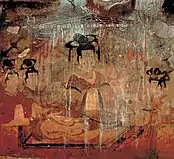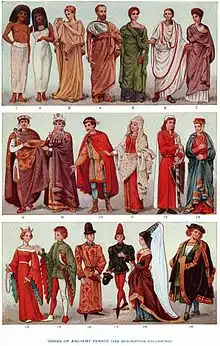Swallow-tailed Hems and Flying Ribbons clothing
Swallow-tailed Hems and Flying Ribbons clothing, also known as zaju chuishao fu (traditional Chinese: 雜裾垂髾服; simplified Chinese: 杂裾垂髾服; pinyin: zájū chuíshāo fú; Wade–Giles: tsa2-chü1 chʻui2-shao1 fu2; Zhuyin Fuhao: ㄗㄚˊ ㄐㄩ ㄔㄨㄟˊ ㄕㄠ ㄈㄨˊ) and Guiyi (袿衣) in Chinese[1] and sometimes referred as "swallow tail" clothing for short in English,[2][3] is a type of hanfu for Chinese women which was popular during the Han,[4] Cao Wei, Jin and Northern and Southern dynasties.[5] It was a common form of aristocratic costumes in the Han and Wei dynasties;[4] it was also a form of formal clothing for elite women.[3]
| Swallow-tailed Hems and Flying Ribbons clothing | |||||||||||
|---|---|---|---|---|---|---|---|---|---|---|---|
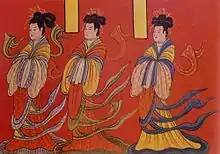 Female figures wearing cross hairstyle with golden headpiece and dressing in the "Swallow-tailed Hems and Flying Ribbons" clothing, early Northern Wei period.
In the right and middle: woman wears guipao (one-piece style). On the left: woman wears guichang, also known as guishu (two-piece style) | |||||||||||
| Traditional Chinese | 雜裾垂髾服 | ||||||||||
| Simplified Chinese | 杂裾垂髾服 | ||||||||||
| |||||||||||
| Guiyi | |||||||||||
| Chinese | 袿衣 | ||||||||||
| |||||||||||
The guiyi can also be divided into 2 styles of clothing based on its cut: i.e. guipao (a form of paofu which is a one-piece robe) and gui chang or gui shu (which follows the ruqun system - upper garment worn with a skirt).[1][4] The clothing was multi-layered and was decorated with an apron-like decorative cloth at the waist with triangular-strips at the bottom and with pieces of ribbons worn underneath the apron which would hung down from the waist.[3] The popularity of ribbons later fell and the decorative hems were eventually enlarged.[3]
History
_por_Ku_K'ai-Chih._Copia_de_la_dinast%C3%ADa_Sung_(960-1279)_seg%C3%BAn_la_obra_original_del_siglo_%E2%85%A3.jpg.webp)
Warring States Period
The term Guiyi was recorded prior to the Han dynasty in the Ode to Goddess by Song Yu, which shows that the Guiyi originated earlier than the Han dynasty.[4] In the Han and Wei period, the Guipao was one of the common aristocratic costumes.[4]
Han dynasty
The guiyi was worn in the Han dynasty as a long one-piece robe called guipao, but seems to have originated from one of the queen's ceremonial clothings of the Zhou dynasty called Sandi (Chinese: 三翟).[1][4] In the Han dynasty, the silk decorations were cut into the shapes of arch, which originated from the Sandi recorded in the Rites of Zhou.[4]
The Guipao was popular in the Han dynasty but the popularity started to fade in the late Eastern Han dynasty.[4] The guiyi which follows the ruqun system also appeared in the Han dynasty, it was called Gui Chang or Gui Shu.[4]
Wei, Jin, Northern and Southern origins
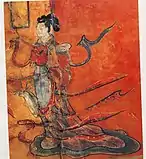
On the whole, the costumes of the Wei and Jin period still followed the patterns of Qin and Han. Women's costumes in the period of Wei and Jin were generally large and loose. The carefree life style brought about the development of women's garments in the direction of extravagant and ornate beauty.[6][5]
During the Northern and Southern dynasties was a period of volatility, the barbarians invaded Central Plain, thus, various wars and battles occurred. The once dominant laws and orders collapsed, so did the once unchallenged power of Confucianism.[5] At the meantime, the philosophy of Laozi and Zhuangzi became popular. Buddhist scriptures were translated, Taoism was developed, and Humanitarian ideology emerged among the aristocrats.[5] However, all these posed a threat to the conservative and imperial power, which tried to crush them by force. These policies forced these scholars to seek comfort and relief in life.[6] They were interested in various kinds of philosophy and studied a lot of the "mysterious learning". They preferred a life of truth and freedom. They dressed themselves in free and casual elegance.
The guiyi worn in the Wei, Jin, Northern, and Southern dynasties evolved from the one-piece long robe (i.e. paofu) worn in the Han dynasty and had wide sleeves.[5] The guiyi are depicted with in the paintings of Gu Kaizhi.[5][1] The ruqun-style guiyi eventually became more popular than the one-piece style during this period as the ruqun became more popular.[1][4] The guiyi also evolved in terms of shape in the Northern and Southern dynasties when the long ribbons were no longer seen and the swallow-tailed corner begame bigger; as a result the flying ribbons and the swallow-tailed corners were combined into one.[2]
Depictions of women wearing guiyi can also be found in Goguryeo tomb murals, as found in the Anak Tomb No.3.[2] The wife of the tomb owner of Anak Tomb No.3 dresses in Chinese guiyi,[2][7] which may indicate the clothing style worn in the Six dynasties.[8] The tomb belongs to a male refugee called Dong Shou (died in 357 AD) who fled from Liaotong to Goguryeo according to Chinese scholar Yeh Pai, a conclusion which is also accepted in the formal Korean report issued in 1958 although some Korean scholars believe the tomb to belong to King Mi-chon.[9]
Construction and Formation
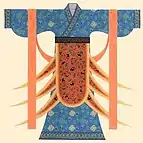
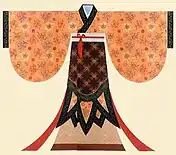
There are two types of guiyi. The guiyi which follows the 'one-piece system' is called Guipao; it is composed of a paofu (a one-piece robe). The other form of guiyi follows the 'separate system', consisting of ruqun (i.e. blouse and skirt).[4]
The change in the Guiyi's shape and structure reflects the historical trend of the fading popularity of Guipao in the late Eastern Han and the increase popularity of the Guiyi in separate system which became mainstream in the Wei, Jin, Southern and Northern dynasties.[4]
The upper garment opened at the front and was tied at the waist. The sleeves were broad and fringed at the cuffs with decorative borders of a different colour. The skirt had spaced coloured stripes and was tied with a white silk band at the waist. There was also an apron between the upper garment and skirt for the purpose of fastening the waist. Apart from wearing a multi-coloured skirt, women also wore other kinds such as the crimson gauze-covered skirt, the red-blue striped gauze double skirt, and the barrel-shaped red gauze skirt. Many of these styles are mentioned in historical records.[10] Wide sleeves and long robes, flying ribbons and floating skirts, elegant and majestic hair ornaments,[6] all these became the fashion style of Wei and Jin female appearance.
Typically the guiyi was decorated with "xian" (襳) and "shao" (髾).[2]
Shao refers to pieces of silk cloth sewn onto the lower hem of the dress, which were wide at the top and narrow at the bottom, so that triangles were formed overlapping each other.[2]
"Xian" refers to some relatively long, silk ribbons which extended from the short-cut skirt.[10][5] While the wearer was walking, these lengthy ribbons made the sharp corners and the lower hem wave like a flying swallow, hence the Chinese phrase "beautiful ribbons and flying swallowtail" (華帶飛髾).[2]
During the Northern and Southern dynasties, the guiyi underwent further changes in style.[2] The long flying ribbons were no longer seen and the swallow-tailed corners became enlarged; as a result, the flying ribbons and swallow-tailed corners were combined into one.[11][2]
Gallery
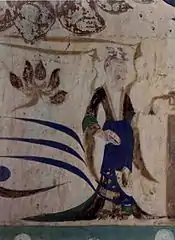 Mogao fresco of a woman dressing in Swallow-tailed Hems and Flying Ribbons clothing, Western Wei dynasty (535–557)
Mogao fresco of a woman dressing in Swallow-tailed Hems and Flying Ribbons clothing, Western Wei dynasty (535–557) Virtuous women of ancient Cathay (China), lacquer painting
Virtuous women of ancient Cathay (China), lacquer painting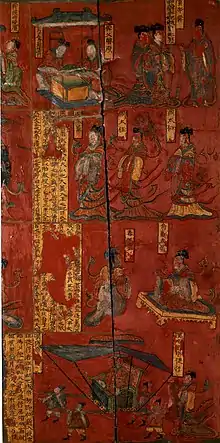 Women dressing in Swallow-tailed Hems and Flying Ribbons clothing, a lacquer painting over a four-panel wooden folding screen, 5th century
Women dressing in Swallow-tailed Hems and Flying Ribbons clothing, a lacquer painting over a four-panel wooden folding screen, 5th century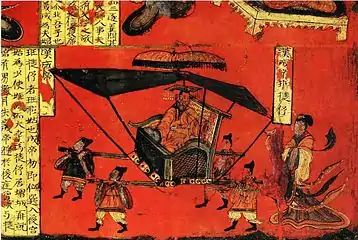 Consort Ban and Emperor Cheng of Han, Consort Pan wearing a Swallow-tailed Hems and Flying Ribbons clothing
Consort Ban and Emperor Cheng of Han, Consort Pan wearing a Swallow-tailed Hems and Flying Ribbons clothing Female figures dressing in Swallow-tailed Hems and Flying Ribbons clothing, 5th century
Female figures dressing in Swallow-tailed Hems and Flying Ribbons clothing, 5th century The virtuous women in Cathayan (Chinese) history, 5th century
The virtuous women in Cathayan (Chinese) history, 5th century_2.jpg.webp) Admonitions of the Court Instructress (detail) by Gu Kaizhi
Admonitions of the Court Instructress (detail) by Gu Kaizhi_4.jpg.webp) Admonitions of the Court Instructress (detail) by Gu Kaizhi
Admonitions of the Court Instructress (detail) by Gu Kaizhi_6.jpg.webp) Admonitions of the Court Instructress (detail) by Gu Kaizhi
Admonitions of the Court Instructress (detail) by Gu Kaizhi_7.jpg.webp) Admonitions of the Court Instructress (detail) by Gu Kaizhi
Admonitions of the Court Instructress (detail) by Gu Kaizhi_1.jpg.webp) Nymph of the Lo River (detail) by Gu Kaizhi
Nymph of the Lo River (detail) by Gu Kaizhi_2.jpg.webp) Nymph of the Lo River (detail) by Gu Kaizhi
Nymph of the Lo River (detail) by Gu Kaizhi_3.jpg.webp) Nymph of the Lo River (detail) by Gu Kaizhi
Nymph of the Lo River (detail) by Gu Kaizhi_4.jpg.webp) Nymph of the Lo River (detail) by Gu Kaizhi
Nymph of the Lo River (detail) by Gu Kaizhi._Southern_Sung_Copy_of_the_Original_Work_by_Ku_K'ai-chih._Freer_Gallery_of_Art%252C_Washington_D.C.jpg.webp) Nymph of the Lo River (detail) by Gu Kaizhi
Nymph of the Lo River (detail) by Gu Kaizhi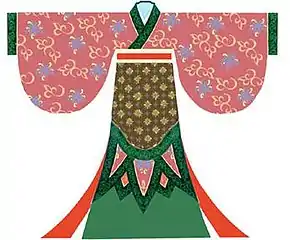 Modern pictorial reconstruction of Swallow-tailed Hems and Flying Ribbons clothing as in Admonitions of the Court Instructress and Nymph of the Lo River
Modern pictorial reconstruction of Swallow-tailed Hems and Flying Ribbons clothing as in Admonitions of the Court Instructress and Nymph of the Lo River
Further reading
- Steele, Ms Valerie; Major, John S. (1999-02-08). China Chic: East Meets West (1st Printing ed.). New Haven: Yale University Press. ISBN 978-0-300-07930-2.
References
- 周方; 服装·艺术设计学院, 东华大学; 周方; 卞向阳; 服装·艺术设计学院,上海200051, 东华大学 (2018-07-02). "罗袿徐转红袖扬 ——关于古代袿衣的几个问题 [Abstract]". 丝绸 (2018年 06). ISSN 1001-7003.
- 5000 years of Chinese costumes. Xun Zhou, Chunming Gao, 周汛, Shanghai Shi xi qu xue xiao. Zhongguo fu zhuang shi yan jiu zu. San Francisco, CA: China Books & Periodicals. 1987. pp. 62–64. ISBN 0-8351-1822-3. OCLC 19814728.
{{cite book}}: CS1 maint: others (link) - Howard, Michael C. (2016). Textiles and clothing of Viet Nam : a history. Jefferson, North Carolina. p. 52. ISBN 978-1-4766-6332-6. OCLC 933520702.
- Bian, Xiang Yang; Zhou, Fang (2018). "A Study on the Origin and Evolution of Shape and Structure of 'Gui-Yi' in Ancient China". Researchgate.
{{cite web}}: CS1 maint: url-status (link) - Hua, Mei; 华梅 (2004). Chinese clothing. 于红. Beijing: China International Press. pp. 12–14. ISBN 7-5085-0612-X. OCLC 61214922.
- "The elegant Wei and Jin Period".
- Chung, Young Yang (2005). Silken threads : a history of embroidery in China, Korea, Japan, and Vietnam. New York: H.N. Abrams. p. 294. ISBN 0-8109-4330-1. OCLC 55019211.
- "Archived copy". Archived from the original on 2011-07-19. Retrieved 2011-04-14.
{{cite web}}: CS1 maint: archived copy as title (link) - The Cambridge history of Japan. John Whitney Hall, 耕造. 山村. Cambridge, UK: Cambridge University Press. 1988–1999. p. 300. ISBN 0-521-22352-0. OCLC 17483588.
{{cite book}}: CS1 maint: date format (link) CS1 maint: others (link) - Duong, Nancy (2013). "Evolution of Chinese Clothing and Cheongsam".
- "Evolution of Chinese Clothing and Cheongsam/Qipao". 2013.
